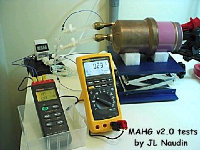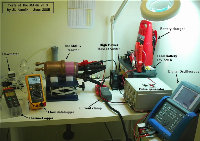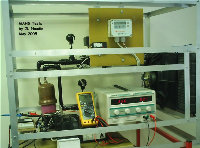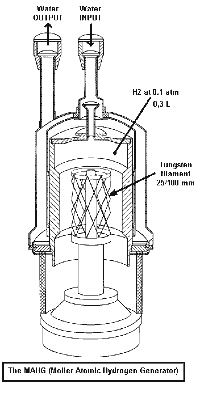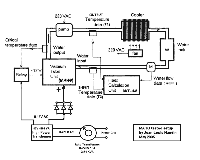J.L. Naudin Claims to Extract Free Energy Using Moller's Atomic Hydrogen Generator (MAHG)
Experimenter claims to derive free energy cleanly and safely from the dissociation and association of hydrogen atoms. Data posted from several tests. Plans, schematics, methods all listed openly to encourage replication and improvement of results. Based on decades-old concepts set forth by Nobel laureate.
by
Sterling D. Allan and
Adrian
Akau
Pure Energy Systems News
Copyright © 2005
|
FRANCE -- French independent researcher
Jean-Louis Naudin reported Friday that he ran his experimental "Moller/Frolov
Atomic Hydrogen Generator" (MAGH) version 2.0 for one hour at an efficiency
of 526% -- that's 5.26 times more energy out than he put in.
The day before, using slightly different settings, he reported having
achieved an efficiency of 682% for twenty minutes. On June 2, he reports to
have run this generator for two hours at an efficiency of 243%.
This is the first known replication and collaboration of the work done by
Nicholas Moller in conjunction with Alexander V. Frolov of Faraday Lab Ltd.
of St. Petersburg, Russia in January 2003. (ref)
Naudin used two completely different types of measurement equipment in his
experiments.
Free Energy
According to Naudin's site, this several-fold excess energy is being derived
somehow in the process of molecular hydrogen dissociating into atomic
hydrogen, and then re-associating into H2. Free energy is
derived, and hydrogen is neither lost nor gained. It is a closed system in
terms of "fuel".
"The Atomic Hydrogen Process is 100% clean and safe," says Naudin on his
site.
Once realized into a commercial product, such a generator would provide the
consumer with a device that would supply energy for free, minus the expense
of the device itself, and any maintenance it might require -- similar to
other free energy sources such as solar or wind energy. The development is
still too young to be able to ascribe a cents-per-kilowatt-hour estimate.
The hope would be that it will be less expensive than any energy technology
available today.
|
Mechanism
In simplistic terms, the MAHG is comprised of a cylinder that has an
input and output channel for water flow around a closed inner chamber filled
with hydrogen at 0.1 atmospheres pressure. A 0.25 mm diameter tungsten
filament at the heart of the device serves as the cathode, where the
Hydrogen reacts to switch between monatomic and diatomic states. Again, the
hydrogen is not consumed in the process of alternating between monatomic H
and H2. Extreme heat is given off as the H atoms recombine to H2.
The water cools the vacuum tube containing hydrogen at 0.1 atmospheres.
The heated water is where the excess energy manifests. The difficulty will
be in efficiently converting that nominal heat into usable energy. We
speculate that a stirling-accoustic engine might be the best mechanism for
efficiently converting that heat to mechanical energy. (See
feedback section below, as well as expired
LANL patent [ref],
and newer thermo-acoustic work at LANL [ref])
The key is found in the frequency characteristics by which the positive
anode and negative cathode are pulsed, to effect a low-energy separation of
the H2 into H. The anode/cathode voltage gradients range between 200 and 300
Volts. AC-driven pulses do not work. The pulses have to be DC, in the range
of 10 megahertz. (See clarifications
in feedback below.) The shape of the pulses is important as well.
The recent improvement in efficiency that Naudin saw, came from changing
from a power-supply-driven voltage pulse, to a battery-driven pulse.
Naudin replaced the power supply by a high power battery connected through a
high power MosFet Switcher. The Switcher is driven by a 10 MHz pulse
generator. Apparently, the battery characteristics provide a better
input reservoir. By using the battery, Naudin was better able to focus the
pulse and gain better results. This is like using a sharp knife instead of a
dull one to dice vegetables. The shape and length of time for the pulse
might be the most important part of the experiment.
Self-run Capability? Not Yet
Jones Beene, an observer of the Naudin results, commented that until someone
is able to make such a device as this self-run, with energy left over to
use, the mainstream scientific community will remain aloof and unsinterested.
Historically, there are too many ways that effects such as this can be
manifest, that have nothing to do with free energy.
Naudin responded, "If I am able to greatly overcome the poor efficiency of
the Carnot cycle at high power and for a long time, with the use of a
high-efficiency TEG (Thermo Electric Generator), it seems possible to build
up a closed-loop device. This is a long way off; a lot of work is required."
Beene has numerous ideas of his own about the MAHG, both about how to
improve the design as well as the theory behind its operation, and the
political ramifications of open sourcing. He expects that a self-runner
could appear quite soon, and then the scenery would change rapidly.
Open Source Project
Naudin reports additional experimental results on his website, along with
photos of his apparatus, descriptions of his protocol, schematics and
diagrams of his set-up, and copies of the data he has obtained during his
experimental runs. He provides a history of the technology as well as an
essay describing the principles and theories that underlie the technology.
The information is clearly intended to be adequate for anyone who wishes to
construct the device and try to replicate the results, or join in the quest
to improve upon them.
"The results are stable and fully reproducible," said Naudin on his site. He
describes the MAHG as one of the best devices that he has tested to date, a
very good candidate for producing a clean and independent energy “for the
benefit of all."
This technology is nearly 70 years old, and is not likely to be patentable.
(A patent was obtained by Frolov in Russia, but a source that request to
remain anonymous states that it is probably not valid). It appears to be a
feasible candidate for the "open source" model of development by interested
scientists worldwide.
Nicholas Moller, one of two individuals after whom this particular variant
(2.0) device is named, said, "The time has come for removing the
responsibility of defining the energy policies and structures of the future
from the hands of the established energy industries, and place it in the
hands of men of science who will work for the preservation of the
environment that sustains all life on Earth." (Quote found on Naudin's
site.)
That does not mean, however, that there will not be contentious attempts to
claim and patent the technology and its various nuances. Beene points out
the problem of "claim jumpers" in some other countries such as Japan, Korea,
and Taiwan; where the "first-to-file" rule trumps "first-to-publish." It
will take a magnanimous spirit by many to see some staking their claims on
this technology while others are freely sharing their ideas. In some
countries, including the U.S., the rule is "first to publish," so open
disclosures on the Internet will preclude the patenting of the idea by
others, ensuring that the technology stays in the open domain in those
countries. Beene further points out that Governments in China, Pakistan,
and the Arab world might seek to obtain international patents, even on some
small technical issue, like a more correct theory or a minor detail of
operation; thus limiting or delaying the commercial implementation by
others.
"Perhaps, since Moller himself has no problem with this open approach, then
no one else should care either. After all, he is the one who is giving up
the most," said Beene.
The rush to derive a clear theory behind how the technology works is also
likely to be animated.
Beene, who has a "bare proton" Dirac hypothesis about how this technology
works, points out that Randall Mills might seek to claim that this is a
hydrino device, while advocates of the low energy nuclear reaction (LENR)
will claim that this is more akin to cold fusion. "The Langmuir explanation,
being the one on which the device was built, is likely to be seen by most as
being operative," says Beene, "but there could be others."
All things considered, Beene concludes, "Yes, let's create something unique
in all of free-enterprise -- the completely open project which benefits the
poor as well as the wealthy -- but also, let's not be naive enough to think
that other forces are not at work to try to keep that from happening."
It may, therefore, be worthwhile to consider the example of Tim Berners-Lee,
inventor of and copyright holder on the World Wide Web. He uses his
copyright as a means to fend off attempts to introduce proprietary programs,
and to keep the web both free and universal, which are both part of the
definition. So, after this example, this publication and others can be used
to establish the “anteriority” of the concept, and such a copyright may
provide at least some leverage to keep the MAHG universal and "free".
Nobel Laureate Irving Langmuir's Discovery
Naudin states that Moller/Frolov's Atomic Hydrogen Generator is based on a
discovery by Irving Langmuir
(1881-1957 b. Brooklyn, N.Y).
Irving Langmuir won the Nobel Prize for Chemistry in 1932. His work on
filaments in gases led to the discovery of the vacuum tube, gas-filled
incandescent light bulbs (the life of tungsten-filament light bulbs would be
lengthened by filling the vacuum with inert gas such as Argon), atomic
hydrogen, and the atomic hydrogen welding process.
Langmuir's doctoral thesis in 1906 at the University of Gottingen in Germany
was entitled "On the Partial Recombination of Dissociated Gases During
Cooling". In 1926, he invented the atomic hydrogen blowpipe in which
hydrogen gas is sent through a small hole through by means of an electric
arc formed by two tungsten rods, reaching temperatures of 3700 degrees
Kelvin (K).
Hydrogen (H2) yields two ("monatomic") atoms of hydrogen,
absorbing 422 kilojoules in the process. The atoms of hydrogen then quickly
recombine into the more stable molecular form giving off extreme heat. The
hydrogen is therefore thought to be a transport mechanism to extract energy
from the arc plasma and to transfer it to a work surface.
Langmuir showed in 1912 that hydrogen at low pressure in contact with a
tungsten wire heated by an electric current is dissociated into atoms and is
accompanied by a large absorption of heat (100kcal per gram molecule). He
used electric currents of 20 amperes and voltages from 300 to 800 volts.
MAHG
In the MAHG (Moller's Atomic Hydrogen Generator), as demonstrated by Naudin,
hydrogen changes between the diatomic and monatomic states without being
used up. In this process, hydrogen appears to be acting as a vacuum energy
pump because an excess of heat results from more energy being released
during the monatomic to diatomic part of the cycle than from the dividing of
the diatomic hydrogen molecules into monotomic hydrogen. Mr. Naudin's
results show that the difference between output and input may reach a ratio
higher than 10 to 1.
What is the mechanism for this excess energy production, and precisely what
is occurring in the plasma? In other words, why is this cycle acting as a
vacuum-energy heat pump? We know that the MAHG works most efficiently with
pulsed DC energy; it has no positive results with AC. The direct-current
pulses must play a part in causing the H2 molecules to break
apart with less energy than when the individual atoms recombine. Why? The
effect of the DC pulse on weakening the bonds must make the difference. A
pulse can be controlled as to its voltage, current and duration.
The recombination of the single hydrogen atoms into H2 molecules,
on the other hand, is a natural event which, to some degree under given
conditions, provides the same amount of output energy.
However, all is not so simple, as temperature is another factor affecting
the efficiency. Mr. Naudin has shown that the efficiency of the energy pump
is greatly increased as the temperature of the hydrogen increases. His chart
(voltage vs current) shows that the resistance of the tungsten filament is
not linear.

Irving Langmuir's 1926 chart shows that at 8,000º K, well above the melting
point of tungsten, the amount of hydrogen dissociated reaches a maximum of
99.9%. Remember that Irving Langmuir was not subjecting the diatomic
hydrogen molecules to voltage pulses.

The curve above shows how the percentage of molecular hydrogen dissociated into atomic hydrogen is related to the temperature of the tungsten. These data were published by Irving Langmuir in March 1926.
The following experimental curve from Naudin, enhanced by the warm to cool
background hues, shows the MAHG filament (the cathode) temperature in
relation to time during the tests.

You may notice that atomic hydrogen (1% to 7%) has been produced during only 25 of each 100 ms. Mr. Naudin's filament (cathode) temperature and time graph, based on data recorded in May 2005, shows that a minimum of 2,000º K must be attained before the hydrogen dissociation process begins. At the peak temperature of just below 3,000º K, there is a 7% dissociation of the diatomic hydrogen molecule into its mono-atomic form.
 |
| Above: The Power I/O Vs the Voltage, the red curve shows the POWER OUTPUT and the blue curve shows the POWER INPUT |
The voltage vs power graph shows that the ratio between the output power and input power is increasing non-linear as the voltage of the pulses increases. Therefore, the voltage itself must also have the effect of increasing the number of dissociations per unit of time, or of increasing the difference in output over input power. Note that both input and output taken individually seem nearly linear except at the lower voltages (below 2 volts).
 |
| Above: In red, the curve of the Power OUTPUT Vs the Power INPUT, the green curve is for 100% efficiency. |
In the new tests on June 23rd, 2005, Naudin made some changes to the
apparatus. He replaced the power supply by a high-power battery connected
through a high-power MosFet Switcher. The Switcher is driven by a 10 MHz
pulse generator. The efficiency of the system went from a maximum of 243% up
to 1153% while the duty of the squared pulse decreased (up to 5%). This
refers to the time interval each DC pulse is acting on the hydrogen
molecule. By using the battery and the special MosFet Switcher, the length
of time for the pulse was shortened by up to 5%. In other words, by using a
more precise pulse, Mr. Naudin was able to achieve much better results than
with the previous pulse produced by a power supply. Apparently, the features
of the new pulse allowed the vacuum energy pump to work more efficiently.
| Comments from Jean-Louis Naudin: These tests demonstrate clearly that the efficiency of the MAHG increases (up to 1153%) while the duty cycle of the squared pulse decreases (up to 5%). |
We expect that Mr. Naudin will present a graph of this new pulse when available.
What Next?
Once others have been able to repeat these results, and the effect fully
characterized, explained, and optimized; the big question will be how
practical this technology will be as a free energy tapping modality.
Solar energy is free energy, but the hardware required to convert photons to
electricity is anything but free. Likewise, even though this MAHG
technology apparently taps free energy, does not automatically mean that it
will solve the world's energy problems. The machine cost and efficiency
will be a primary consideration in the practicality of the technology for
commercial application. Preliminary results and extrapolations
appear promising for the MAHG. Further studies and development will answer
that question more definitively.
In an email granting permission to use the images that appear in this
article, Naudin said, "I hope that my modest contribution of my researches
about this fascinating device will soon give us a clean energy source for
the future and will contribute to saving our planet".
Beene gives his opinion that "of all the many projects going-on in
alternative energy right now, this is by far the closest thing to
being a demonstrable (and shocking) success within the next 6 month
time-frame. By success, I mean self-powered overunity leading to an
immediate commercial prototype - or at least something which cannot be
denied by the mainstream of physics as being overunity (probably ZPE) and
instantly marketable."
In the throws of this recent success, Naudin's assessment of this technology
is that it rises to the status of the "Holy Grail" of energy.
Follow-up
If you are interested in pursuing this concept, there is a project list
that pursues various iterations of the atomic hydrogen generator concept
such as JL Naudin's MAHG above. The group is designed for those wishing to
replicate, improve, and develop theories for this fascinating concept.
http://groups.yahoo.com/group/aH-gen
(See Feedback, below, for additional pertinent
information.)
# # #
ACKNOWLEDGEMENTS
- Thanks to Jean-Louis Naudin for his cooperation in providing input and image permissions for this story, as well as for the great work he is doing in research and development.
- Special thanks to Adrian Akau and Terry Holmes who brought this development to our attention; and to Adrian for his assistance in composing this story.
- Mary-Sue Haliburton provided editorial assistance.
SOURCES
- Extensive email correspondence with JL Naudin, who reviewed a near to final draft of the above story and said, "Thanks for your very well documented paper about the MAHG and for your contribution to this fascinating project."
- Email correspondence with Alexandar Frolov.
- Email correspondence with Jones Beene.
- http://jlnlabs.imars.com/mahg/index.htm - MAHG Project home page
- Data Reports
- http://jlnlabs.imars.com/mahg/tests/lrtests.htm - 2-hour test run with 243% efficiency (June 2, 2005)
- http://jlnlabs.imars.com/mahg/tests/pultests.htm - Towards high efficiency in excess of 1000%. "The purpose of these tests is to improve the MAHG efficiency so as to overcome the losses due to the poor efficiency of the Carnot cycle at the MAHG output." (June 20, 2005)
- http://jlnlabs.imars.com/mahg/tests/mahg2a.htm - High efficiency confirmed with a new tests bench. "During the RUN #74 all the datas [sic] have been recorded during 20 minutes, the average power output measured was 90.56 watts with only 13,22 watts at the input. The delta T was 2.8°C with a cooling water flow of 0.54 L/min. The average efficiency measured was 682 % during this test." (June 23, 2005)
- http://jlnlabs.imars.com/mahg/tests/mahg2b.htm - MAHG v2.0: one hour test run at 526%. "This 1 hour test confirms again all the previous measurements done with the MAHG." "During the RUN 75, the average power output measured was 66,5 Watt with only 12,5 Watt at the input. The delta T was 4,6°C with an average cooling water flow of 0.24 L/min. The average efficiency measured was 526 % during this test." (June 24, 2005)
- http://jlnlabs.imars.com/mahg/tests/index.htm - Full tests of the MAHG by JL Naudin (May 23, 2005)
- http://jlnlabs.imars.com/mahg/logbook.htm - Genesis phase of the project; 1st preliminary experimental tests results. (March 1, 2004)
- Instructions
- http://jlnlabs.imars.com/mahg/diagram.htm - The MAHG full construction diagrams.
- http://jlnlabs.imars.com/mahg/setup.htm - The MAHG experimental tests setups. (March 1, 2004)
- History:
- http://jlnlabs.imars.com/mahg/mahg1.htm - Documentation of genesis phase of the project, in which Alexandar Frolov of St. Petersburg, Russia, tested inventor, Nicholas Moller's, device (1.0), to demonstrate Langmuir's principle. (March 1, 2004)
- http://jlnlabs.imars.com/mahg/photos.htm - The MAHG photos album, with descriptions and labels. (March 1, 2004)
- Article: http://jlnlabs.imars.com/mahg/article.htm - Irving Langmuir and Atomic Hydrogen by Nicholas Moller
- Forum: http://groups.yahoo.com/group/jlnlabs/ - Naudin's discussion list covers a wide array of free energy topics. The forum is moderated and selective in what it allows.
ADDITIONAL READING
- The Atomic Hydrogen Reaction - Tom Bearden introduces William Lyne's book Occult Ether Physics. (July 6, 2003)
- Carnot Excedence - Patent and Mathematical Proofs by Kenneth Rauen, Science Advisor for PES Network Inc., show that super-efficient thermodynamic exchange is possible. (Pure Energy Systems; June 28, 2004)
CONTACTS
- Jean-Louis Naudin : jnaudin509@aol.com
- Alexander Frolov : office@faraday.ru
- Jones Beene : jonesb9@pacbell.net
- Nicholas Moller : wavebalance@icqmail.com
Feedback
Roles of Frolov & Moller Specified
From: "Faraday Lab" <office@faraday.ru>
Sent: Monday, June 27, 2005 12:55 AM
Subject: RE: role of Frolov
Moller had idea to test hydrogen recombination efficiency. Design of the
vacuum tube was made by me with local factory. In my research lab here in
St.Petersburg it was tested in different modes and then it was discovered
that recombination is only particular case. Now we have new results without
hydrogen recombination. Future testing will are planned in Australia.
Alexander V. Frolov
* * * *
From: "Alexander V. Frolov"
To: <FE_updates@yahoogroups.com>
Sent: Monday, June 27, 2005 1:16 AM
Subject: MAHG energy breakthrough;
I am happy to see independent positive confirmation of my invention. Moller
knew nothing about this way but he proposed to work on this topic and he
paid 50% of cost. Also we have contract about 50-50 on the topic (including
authorship). So, please remember who is real author...
Alexander V. Frolov
* * * *
Pulse Voltage and Frequency
From: "Jones Beene" <jonesb9@pacbell.net>
Sent: Sunday, June 26, 2005 5:05 PM
Subject: Re: integrated: More MAHG & BLP
"The key is found in the frequency characteristics by
which the positive anode and negative cathode are
pulsed, to effect a low-energy separation of the H2
into H. The anode/cathode voltage gradients range
between 200 and 300 Volts. "
OK, that was the older work - the newer work uses far less voltage and lower
frequency. From 5.5 volts down to only one-half volt is now the standard for
the higher efficiency. This would not be adequate to
create mono-atomic hydrogen in normal physics.
Also:
"AC-driven pulses do not work. The pulses have to be
DC, in the range of 10 megahertz."
Now, the newer work uses much lower frequency - only 50+ hz combined with a
very low duty factor (TDC) of ~10% yet still managing to draw over 20 amps.
Most observers would think of that as nearly impossible.
* * * *
Stirling-Accoustic Engines and Tapping Low Delta T
IF the present MAHG 2.0 results hold or improve, currently a COP greater than 5 is seen, then the quandary presents itself - how do you convert that excess heat, and the very small delta-T back into electricity, at a Carnot efficiency of greater than 20% - in order to self-power. This level of performance is adequate to self-power if other technology can be "borrowed".
Fortunately, the most obvious conversion modality for a situation where the energy has an acoustic frequency component involves **thermoacoustics.** It is not really all that complicated and some top-notch labs are currently showing good results.
The term "Stirling-Acoustic" is often used, although there is no reason to confuse this situation with the original "Stirling" concept- as now the conversion modality is becoming more like a linear transducer (i.e. loudspeaker) and less like a regular stirling, which probably will not work efficiently with that low Delta-T.
Whereas acoustic implementation will probably actually benefit from the low (330 K ) tube temperature as the P/V effects are capable of inclusion with an alteration of the MAHG tube. LANL claims 30% Carnot efficiency now. The original expired LANL patent can be seen here: http://www.delphion.com/details?pn=US04599551__
here is the main link for the project: http://www.lanl.gov/mst/engine/
and here is the important but not-expired patent at: http://www.delphion.com/details?pn=US05892293__ which is the Macrosonix patent, and clearly not all that distinguishable from the older and expired LANL patent. Its validity has is therefore suspect, in light of prior art, but has not been challenged AFAIK.
Anyway, thermo-acoustics is definitely the easiest path to self-power for the MAHG.
First however, one needs to fashion the MAHG tube itself into the form of a **bellows,** such as the Slyphon "Seamless Metal Bellows" but formed with an "active" metal sputter coating on the inside of a "springy tube... for instance a beryllium copper bellows would be perfect, which is also becomes the anode. We dispense with the water circuit and air cool the tube to 300K.
Tungsten is now used in MAHG. A valid question remains - is the effect limited to W ? As I posted earlier, the results of fuel-cell experiments seem to indicate that a Pd-Ru alloy approx 50/50 is superior - either sputtered or electroplated, but FCs are not the same beast as the Langmuir torch - despite some hidden similarities - and that level of "refinement" is all part of the tedious process of prototype engineering, following a proof-of-concept which can use tungsten.
Additionally - with thermoacoustics, it might easily be possible to capitalize on the Alfven-effect - which is a thermoacoustic resonance effect at low frequency... not that we need another synergy, but why turn it down?
It is all very exciting and bursting with the promise of the real "holy grail" of advancing technology -- free-energy through ZPE coherence.
Jones
* * * *
From: "Terry Holmes" <tholmes@mail.telis.org>
Sent: Sunday, June 26, 2005 7:22 PM
Subject: Re: integrated: More MAHG & BLP
Jones,
As far as Stirling engines go, James Senft's 1996 book "Low Temperature
Differential Stirling Engines", gradients as low as 1/2 degree C can drive
a Stirling Engine. However, he says that whether they can be put to
practical use is an "open question". I don't know if any commercial
progress has been made over the past 9 years.
The Bearden site below discusses "bare proton" photon emission as
related to Langmuir's experimental results. Perhaps his theory is related to
yours.
http://cheniere.org/misc/a_h%20reaction.htm
Terry
* * * *
Energy Out / Energy In
Some
response to Naudin’s test of the Moller H2 Generator – see below.
(This is
from the world’s leading expert on H2 Generation, founder of Millenium
Cell Corp.)
The others
were similar in form.
[JD]
From:
Steven Amendola <
email
>
Sent: Tuesday, May 31, 2005
11:55 PM
Subject: Re: Novel H2
generation sys. ?
First of all he is totally
incorrect stating that efficiency is Power Out / Power In.
Efficiency is Energy Out /
Energy In.
By his definition even a
capacitor can achieve 1000's% efficiency since they can discharge much
faster than they charge. (Even a released spring can do that)
This is all he is seeing. He
makes atomic H at some rate and it decomposes at a faster rate because its
unstable.
He may be storing energy in
the form of atomic hydrogen. (Just H instead of H2) While this could store
a fair amount of energy per unit weight, it is known that atomic hydrogen
is very unstable and readily recombines in a couple of seconds. He has
done nothing to mitigate this instability, thus I can't see it as a
storage method either.
Thanks,
Steve
See also
- Global Institute for New Energy Technologies - GIFNET, headed by Nicholas Moller (namesake of the MAHG) is a European non-profit organization established in 2003 to assist in the development of exotic alternative energy technologies. UN General Secretary Kofi Annan visited their lab June 13. (PESWiki; July 14, 2005)
- Hydrogen Technologies (index at FreeEnergyNews.com)
- Stirling Engine (index at FreeEnergyNews.com)
- PESN (Pure Energy Systems News) - feature stories
- This Week in Free Energy™ - Weekly five minute blurb.
Page composed by
Sterling D. Allan June 25, 2005
Last updated
